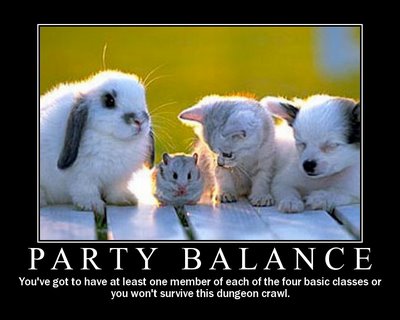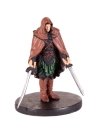No, really... HIGH magic... beware....
This is an idea I came up with while thumbing through my copy of the Expanded Psionics Handbook. Yeah, psionics will be involved here so if you just can't stand 'em you won't get much from this post.
So I came upon the Cerebremancer PrC and thought "this looks familiar." Sure enough, it's exactly like the Mystic Theurge PrC except it involves an arcane spellcasting class and a psionic class instead of a divine spellcasting class. Well that's cool, I wonder if there's a divine/psionic PrC? Sadly, I was unable to find one. But, it's a pretty simple and straightforward PrC idea so I made one:
Enlightened Minds
Requirements:
Skills: Knowledge (psionics) 6 ranks, Knowledge (religion) 6 ranks.
Spells: Able to cast 2nd-level divine spells.
Psionics: Able to manifest 2nd-level powers.
Class Skills:
Concentration (Con), Craft (Int), Knowledge (psionics) (Int), Knowledge (religion) (Int), Profession (Wis), Psicraft (Int), Sense Motive (Wis), and Spellcraft (Int).
Skill Points at Each Level: 2 + Int modifier.
Class Features:
Weapon and Armor Proficiency: Enlightened minds gain no proficiency with any weapon or armor.
Spells per Day/Powers Known:
When a new enlightened mind level is gained, the character gains new spells per day and spells known as if he had also attained a level in any one divine spellcasting class he belonged to before he added the prestige class. He gains additional power points per day and access to new powers as if he had also gained a level in any one manifesting class he belonged to previously. He does not, however, gain any other benefit a character of either class would have gained (bonus metapsionic or item creation feats, psicrystal special abilities, and so on). This essentially means that he adds the level of enlightened mind to the level of whatever other divine spellcasting class and manifesting class the character has, then determines spells per day, caster level, power points per day, powers known, spells known, and manifester level accordingly.
For example, a 3rd-level cleric/3rd-level psion who takes a level in enlightened mind has the same access to spells as a 4th-level cleric and the same number of power points as a 4th-level psion. But he continues to turn undead as a 3rd-level cleric, and his psicrystal (if he has one) won’t gain any new abilities.
If a character had more than one divine spellcasting class or more than one manifesting class before he became a enlightened mind, he must decide to which class he adds each level of enlightened mind for purpose of determining spells per day, spells known, caster level, power points per day, powers known, and manifester level.
Got all that? Ok good. Now we have three PrCs that are slight variations on each other. But what good is making a new class if you're not going to use it? So I came up with a neat campaign idea, but sadly lack the players or a proper DM (I wouldn't do it justice) to pull it off. So I'll post it here and hopefully someone will like it enough to give it a try. If you do, let me know how it turns out. I'll even post some of your exploits up here if you want. Ok, down to business. First, there are two groups of three:
Group A:
Cleric/Wizard/Mystic Theurge
Wizard/Psion/Cerebremancer
Cleric/Psion/Enlightened Mind
Group B:
Favored Soul/Sorcerer/Mystic Theurge
Sorcerer/Wilder/Cerebremancer
Favored Soul/Wilder/Enlightened Mind
If you're like me, you're squealing with anticipation right now. What can I say? I like balance (in the cosmic sense).
The actual nature of the campaign can take on many forms. I suggest three OR six players.
With 3 players either:
Choose either group and the group left over is NPCed and becomes a rival group.
Choose either group and forget the other.
OR
Players play both groups in parallel (either competing or cooperating).
With 6 players either:
Play both groups as one large group.
OR
Play both groups in parallel (either competing or cooperating).
The only part of the character development that the players don't have control over is class progression. The characters alternate their base classes and take the requirements for their PrCs as soon as possible (yeah I know that controls some skill choices as well). As soon as they meet the requirements for their PrC they must take at least 1 level in it. They cannot gain more than 5 levels in either of their base classes and cannot take levels in any other class. This makes everyone end up as "Base class A" 5/"Base class B" 5/PrC 10. All other development choices can be made by the player (familiars, psicrystals, deities, domains, spell/power lists, etc.).
I know this isn't a campaign for everyone, but if you know people who would like to give it a shot then go for it. I know I'd love to play it. Along those lines, I do game over the internet on FantasyGrounds, so if you want to try to get it started on there I'd be up for it.
That's all for today.
Tags:
high magic, campaign, mystic theurge, cerebremancer, enlightened mind, prestige class, cleric, wizard, psion, favored soul, sorcerer, wilder, Dungeons and Dragons, D&D, D20Labels: cleric, D and D, d20, Dungeons and Dragons, favored soul, gestalt, magic, multiclass, prestige class, psion, sorcerer, wilder, wizard












